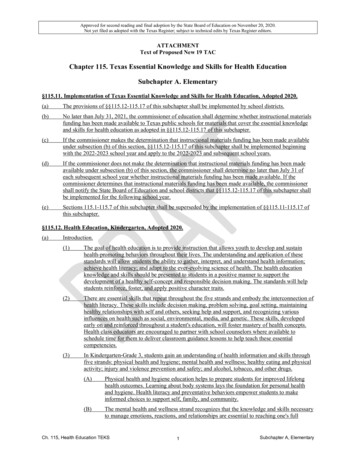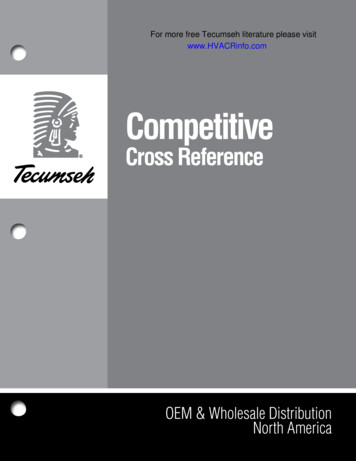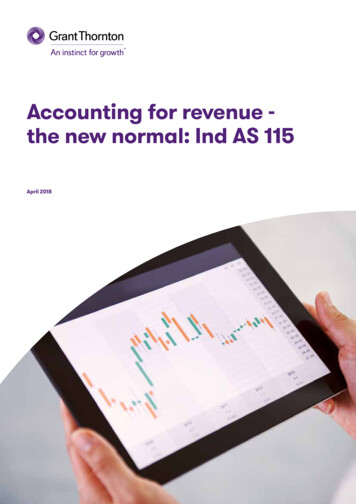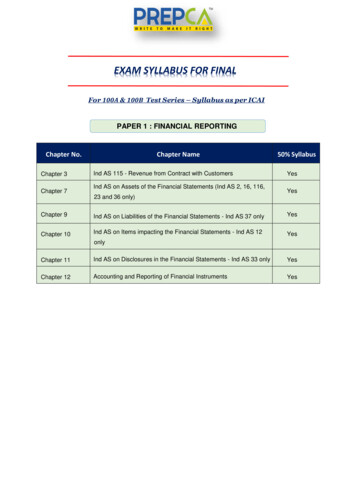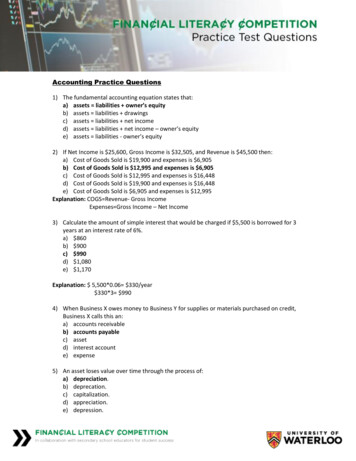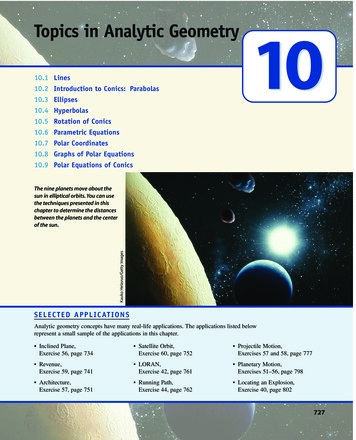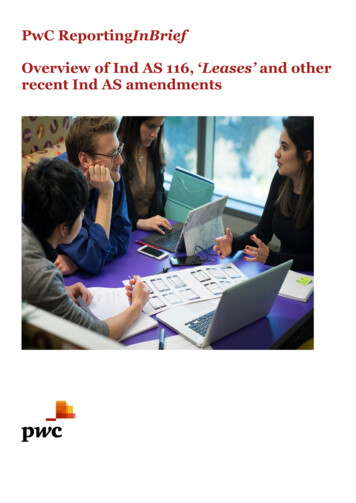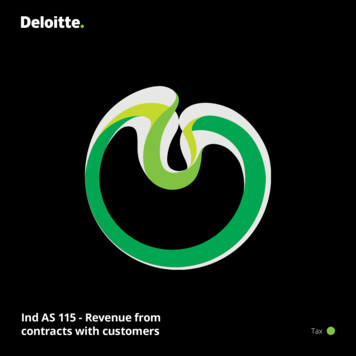
Transcription
Ind AS 115 - Revenue fromcontracts with customers
Ind AS 115 - Revenue from contracts with customersInd AS 115 - Revenue from contractswith customersThe Ministry of Corporate Affairs (MCA) notified 39 Indianaccounting standards (Ind AS) on 16 February 2015. Thesestandards include Ind AS 115, which was converged with theInternational Financial Reporting Standards (IFRS) 15.Following the deferral of IFRS 15 to 1 January 2018, the MCAalso deferred the application of Ind AS 115 on 30 March 2016,and issued Ind AS 11 (construction contract) and Ind AS 181Identify theContract with theCustomer2Identify thePerformanceObligationsAssess whether thecontract is within thescope of Ind AS 115.“Customer” is now adefined term(revenue recognition). On 28 March 2018, the MCA notified IndAS 115, a new revenue recognition standard that replacesexisting Ind AS 11 and Ind AS 18. The new standard alsoreplaces guidance notes on real estate revenue recognition.Ind AS 115 is applicable from 1 April 2018, i.e., FY 2018–19. Thecore principle of Ind AS 115 is that revenue needs to berecognised when an entity transfers the control of goods andservices to customers at an amount that the entity expects tobe entitled. Ind AS 115 is based on a five-step model shownbelow:Determine whetherthe goods andservices in thecontract are distinct34Determine theTransactionPriceDetermine fixedand variableconsiderationAllocate theTransactionPriceAllocate based on arelative stand-aloneselling price basisusing acceptablemethods5RecognizeRevenue when (oras) PerformanceObligations aresatisfiedRecognise revenue ata point in time or overthe period of timebased on performanceobligationsKey areas:Free goods andservicesLicensingarrangementsOption foradditional good/servicesBidding costsRight to returnTake or paycontractsTransition to Ind AS 115Any impact of transition to Ind AS 115 needs to be given in opening retained earnings, as on 1 April 2018. The entity wouldcompare the revenue recognised as per Ind AS 18 / Ind AS 11 / IGAAP / Guidance Note for each arrangement (in respect of opencontracts, as on 31 March 2018) with amount that would have been recognised as per Ind AS 115. The difference between thesetwo amounts would be accounted as a cumulative catch up adjustment and recognised on 1 April 2018 in opening retainedearnings. Modified retrospective and retrospective are two transition approaches available that the entity may adopt fortransitioning to Ind AS 115.03
Ind AS 115 - Revenue from contracts with customersModified Retrospective ApproachCumulative Catch upYear ending 31 March 201931 March 2018Initial Application YearPrior YearNew contractsInd AS 115–Existing contractsInd AS 115 cumulative catch upLegacy GAAPCompleted contracts–Legacy GAAPRetrospective ApproachCumulative Catch upYear ending 31 March 201931 March 2018Initial Application YearPrior YearNew contractsInd AS 115–Existing contractsInd AS 115Ind AS 115 cumulative catch upCompleted contracts–Ind AS 115* cumulative catch up* Practical expedient available for completed contracts – an entity is not required to restate contracts that begin and end within the same annual reportingperiodKey Transition ConsiderationsBased on transition options followed globally1, nearly 58% ofthe industries (including technology, pharmaceutical,automotive, engineering and construction, fast movingconsumer goods, media, and telecom) have adopted themodified retrospective approach. About 20% industries,including aviation, media and metal and mining, have adoptedthe full retrospective approach. The remaining 22% industriesare under assessment or have not made disclosures.However, in India2, nearly 34% of the industries (such as realestate, retail, life sciences and healthcare, shipping, logistics,construction, and engineering, procurement, and12Source: Data compiled by Deloitte from sample of 113 Global CompaniesSource: Data compiled by Deloitte from sample of 176 Indian Companies04commencement) have adopted the modified retrospectiveapproach. Only 2% industries, including retail and real estate,have adopted the full retrospective approach, while theremaining 64% industries have not published their disclosuresor have not made disclosures.Regardless of the transition method companies choose, manycompanies will have to apply the standard to contractsentered into earlier. The number of contracts will be higherunder the full retrospective approach. However, under themodified retrospective approach, companies will at least haveto apply Ind AS 115 to all contracts that are not completed ason the date of initial application.
Ind AS 115 - Revenue from contracts with customersCompanies should appropriately evaluate the effectiveness ofthe approach considering all practical expedients, changesrequired in IT systems and processes to generate historicalanalysis, and impact on financial statements.Tax implications on transition toInd AS 115 on MAT For the entities that adopted Ind AS on or after1 April 2018 – The adjustment made to retained earningswill be a part of “transition amount” and book profit can beincreased or decreased by 1/5th the amount in each yearstarting from convergence year and the subsequent fouryears, subject to certain exceptions. For the entities that adopted Ind AS before 1 April 2018 –According to provisions in the Income Tax Act, 1961 (the Act),transition amount means the amount adjusted in the otherequity on the convergence date. Ind AS 101 defines “first IndAS reporting period” as the latest reporting period coveredby an entity’s “first Ind AS financial statement”. Thus,“convergence date” will occur only once in the lifetime of thecompany when it adopts Ind AS. The substitution of one IndAS with another, pursuant to the notification of new Ind AS,is different from ‘convergence date’. Hence, the adjustmentmade to retained earnings on the adoption of Ind AS 115will not be a part of ‘transition amount’. Accordingly, inthe absence of specific provisions in the Act, based on thedecision of the Supreme Court in case of Apollo Tyres, noadjustment can be made to book profit.The above-mentioned implications may lead to doubletaxation or double non-taxation. Representation needs tobe made to the Central Board of Direct Taxes to provide aclarification on this aspect.05
Ind AS 115 - Revenue from contracts with customers06
Ind AS 115 - Revenue from contracts with customers07
Ind AS 115 - Revenue from contracts with customersImpact of Ind AS 115 – Examples01. Real EstateKey building blocks of changeTiming ofrevenue recognition Guidance Note on Real Estatenot carried over Careful evaluation ofarrangements for continuingPercentage of completionmethodVariableconsiderationPerformance obligation(distinct or same) Significant financingcomponent (e.g. subventionschemes) Parcel of land sold as part of acontract for the construction ofa building Bonus, rental guarantees andprofit sharing Whether design phase distinctfrom construction and/or operation phases of thecontract Common amenities like gym,parking lot and swimming poolUnder Ind AS 115, revenue should be recognised over time ifeither of the following conditions is met:i. Buyers take all the benefits of the property as real estatedevelopers construct the property.ii. Buyers obtain physical possession of the property.iii. The property unit to be delivered is specified in thecontract and real estate entity does not have analternative use of the unit; the buyer does not have thediscretion to terminate the contract and the entity hasright to payment for work completed to date.In case none of these conditions is met, revenue would berecognised at a point in time when the control of the propertyis passed on to the customer.3Source: Data compiled by Deloitte from sample of 16 real estate companies08Tax implicationsFor tax purposes, profits and gains arising from aconstruction contract needs to be determined usingthe percentage of completion method. There could bedifferences in the recognition of income under accountingand tax purposes.Based on the analysis of quarterly results of real estatecompanies3, nearly 81% of the companies have made adisclosure regarding impact or no impact due to Ind AS115 and about 19% of the companies have not providedany disclosures. Further, of the companies makingdisclosures, nearly 85% have been significantly affectedby changing the method of revenue recognition as per
Ind AS 115 - Revenue from contracts with customersInd AS 115. Only 15% of these real estate companies havenot been materially affected.Further, according to recent news report4, due to theadoption of Ind AS 115, real estate companies may takea write-back of profit of about INR 20,000 crore. Thismay have a significant impact on MAT computationfor companies that have adopted Ind AS before 1 April2018. This is because the adjustment made to retainedearnings on the write-back of profit following theadoption of Ind AS 115 will not be a part of ‘transitionamount’. In the absence of specific provisions in the Act,companies may not be in a position to claim deductionfor the write-back of profit while computing book profitunder MAT. Such a situation may lead to double taxationas the same profit will be subject to tax twice (i) whenthe profit would have been credited to the profit and lossaccount in the past years before the adoption of Ind AS115 and (ii) again when the profit will be credited to theprofit and loss account in the year in which performanceobligation is met.02. Bundled contractsIdentifying performance obligations and allocation oftransaction priceHandsetNetworkContractFor example, in January 2018, customers A and B enterinto a two-year contract with a wireless company (ABC).ABC offers two handsets, along with a two-year servicecontract. The first handset is a model that has beenin the market for 18 months, and ABC gives it for free4(standalone selling price is INR 250). The second handsetis the newest version of the phone with improved featuresand functionality. ABC offers this handset for INR 160(standalone selling price is INR 380). Both the offers areunder the subsidy model, where customers pay a lowerprice of a handset and sign a two-year service contract.Let us assume that ABC does not charge activation fee.Over a two-year contract, ABC offers a 1 GB data plan withunlimited voice and text messages for INR 40 per month.Let us assume the standalone selling price of the plan isINR 40 per month. If more than 1 GB data is used, datausage is rounded up to the next GB and priced at INR 10per extra GB. This is the standard price for all customers.The service plan is cancellable. However, the customer issubject to the early-termination penalty of INR 320, whichdecreases on a pro rata basis over the contract term.Customer A selects the older model phone, whilecustomer B selects the newer model. Both the customersselect the 1 GB data plan (with unlimited voice andtext messages).EvaluationCurrent AS 9 does not require revenue from contractsto be separately allocated to different elements. IndAS 18 requires the recognition criteria to be appliedto the separately identifiable components of a singletransaction to reflect the substance of the transaction.However, there is no specific guidance on how to allocatetransaction price.Ind AS 115 provides the method to allocate transactionprice among different performance obligations. In thecurrent example, the customer can benefit from thehandset and network service either on their own orET, 11 June 2018 – New Accounting Rules may give a INR 20,000 crore blow to builders09
Ind AS 115 - Revenue from contracts with customerstogether with other resources that are readily availableto the customer. In addition, the handset and networkservice are separately identifiable. The table belowPerformance obligationillustrates differences in the allocation of transactionprice and revenue recognised between the likely currentpractice and Ind AS 115:Likely current practice (contract price )Ind AS 115 (proportionate allocation)Customer ACustomer BCustomer ACustomer BHandset Revenue0160198317Wireless Service Revenue960960762803Total Revenue9601,1209601,120Handset revenue for Customer A: [INR 250 / (INR 960 INR 250) x INR 960]. For Customer B: [INR 380 / (INR 960 INR 380) x INR 1,120]Wireless service revenue for Customers A: [INR 960 / (1NR 960 INR 250) x INR 960]. For customer B: [INR 960/ (INR 960 INR 380) x INR 1,120]Tax implicationsWhat should be the approach for tax purposes to aboveaccounting treatment vis-a-vis the current accountingpractice that needs deliberation? Can revenue be offeredto tax as per the agreement or in term of section 145 ofthe Act? Can revenue be offered as per the method ofaccounting employed by the assesse? These scenariosneed to be analysed in details and appropriate positionmay be taken on a case-by-case basis.Based on the analysis of the quarterly results of telecomcompanies5, all companies have made a disclosurestating that impact on the adoption of the standard isinsignificant.03. Non-refundable upfront feeIn many transactions, customer may pay an upfront fee atthe commencement of a contract. The fee may relate to5Source: Data compiled by Deloitte from a sample of two telecom companies10the initiation, activation, or procurement of a good to beused or a service to be provided in the future. Ind AS 115requires entities to determine whether an upfront fee isrelated to the transfer of a promised good or service.In addition, Ind AS 115 notes that non-refundable upfrontfee is often related to activities an entity must undertakeat or around the beginning of a contract. However, thoseactivities may not result in the transfer of a good or serviceto the customer. In such circumstances, the upfront fee mayrepresent an advance payment for goods or services to beprovided in the future and would be recognised when thosegoods or services are transferred to the customer.For example, a software entity enters into a contract witha customer to provide a software licence and one-yearsubscription to cloud services, wherein the considerationto be paid by the customer is a non-refundable upfrontpayment of INR 10,00,000 and an annual fee of INR
Ind AS 115 - Revenue from contracts with customers5,00,000. The customer has right to renew cloud serviceseach year for INR 5,00,000.The entity has assessed that the software licence andcloud services are a single performance obligation, as thesoftware licence can only be used with the entity's cloudservices.The entity assesses that upfront fee is not associatedwith the transfer of any goods or services and representsa material renewal right because renewal price insubsequent years is lower than the amount paid (INR15,00,000) in the first year.The entity will value the renewal right based on theaverage tenure of customer relationship. Consequently,upfront fee will be recognised over the customer contractor relationship period (after considering contract renewal).Another exapmle could be of a bank or non-bankingfinancial company which enters into a contract with acustomer to provide a loan, wherein the customer isrequired to pay a non-refundable upfront processing feeand annual interest. The loan is for a period of five years.According to Ind AS, the processing fee will be amortisedover the expected life of the loan based on the effectiveinterest rate method.Under the existing practice, these fees are recorded asincome immediately on receipt whenever the agreementis signed.11
Ind AS 115 - Revenue from contracts with customersTax implicationsFor tax purposes, detailed analysis is required todetermine whether non-refundable upfront fee needsto be offered for tax as income immediately on receiptin the first year or the fee can be spread over thecontract period. The analysis is based on the terms of theagreement, rights of the customer, and available judicialprecedents on the issue.04. Power and UtilityCertain long-term contracts often include significantvariable elements, such as: Penalties DiscountsThere are new specific requirements in respect of variableconsideration. According to these requirements, variableconsideration is only included in transaction price if itis highly probable that the revenue recognised wouldnot be subject to significant future reversals as a resultof subsequent re-estimation. In certain scenarios, asignificant degree of judgement is required to estimatethe amount of consideration that should be taken intoaccount.When transaction price includes a variable amount, anentity must estimate variable consideration using one ofthe following approaches (whichever gives an accurateprediction of the amount to which the entity expects to beentitled): An “expected value” (probability-weighted) approach A “most likely amount” approachFor example, an entity enters into an agreement to sell6Source: Data compiled by Deloitte from a sample of four power and utility companies1210,000 units of electricity in a year at INR 5 per unit.However, if the entity is unable to supply the contractedelectricity, the price per unit will be reduced to INR 3 perunit for deficit beyond 1,000 units.In this situation, the company needs to estimate at thebeginning of the year how many units it can supply. If thecompany estimates that it can only supply 8,000 units ofelectricity, revenue should be recognised for INR 3 per unitdelivered (irrespective of the billing being made at INR 5per until the final annual reconciliation).By the end of 31 March 2019, only 5,000 units have beensold at INR 5. The revenue to be recognised will be atINR 15,000 (5,000*INR 3) and the balance amount of INR10,000 (5,000*INR 2) would be recognised as advance.Tax implicationsAccording to the income computation and disclosurestandards, revenue can be recognised when there isreasonable certainty of ultimate collection. Based on this,one can argue that certainty is lacking for the collection ofINR 2. Hence, only INR 3 can be recognised and offered asincome. The view needs detailed analysis and support tosubstantiate the argument.Based on the analysis of the quarterly results of powerand utility companies6, companies have made a disclosureregarding impact or no impact due to Ind AS 115. However,only 25% companies have been significantly affectedby changing the method of revenue recognition. Theremaining 75% power companies have not been materiallyaffected or yet to assess the impact due to a change inaccounting method.
Ind AS 115 - Revenue from contracts with customers13
SummaryCompanies following Ind AS have started applying Ind AS 115 from 1 April 2018 onwards and published their June Septemberquarterly financial results using Ind AS 115 principles. Ind AS 115 requires revenue to be recognised when an entity transfers thecontrol of goods or services to a customer at an amount to which the entity expects to be entitled following a five-step model.Based on these quarterly results, we understand that companies preferred the modified retrospective approach over theretrospective approach for transition from Ind AS 18 and Ind AS 11 to Ind AS 115. Companies have started analysing contracts oragreements with customers to determine the impact of Ind AS 115 on their financials. They have also disclosed material impactin notes to these quarterly results. As per the reported data, amongst others sectors of the industry (such as retail, shipping andlogistics, and fast moving consumer goods), real estate witnessed the highest impact. In the future, real estate developers willrecognise revenue on the completed contract method in case of an under-construction property, as against the percentage ofcompletion method.This being the first year, companies are still evaluating the impact of the new accounting method and will make appropriatedisclosures by year-end (March 2019 results). Thus, preparing for Ind AS 115 is more than an accounting change. Hence, werecommend that companies must evaluate the tax aspect of revenue recognition due to a change in the accounting methodbefore the closing of account books for March 2019.
Deloitte refers to one or more of Deloitte Touche Tohmatsu Limited, a UK private companylimited by guarantee (“DTTL”), its network of member firms, and their related entities. DTTL andeach of its member firms are legally separate and independent entities. DTTL (also referred to as“Deloitte Global”) does not provide services to clients. Please see www.deloitte.com/about for amore detailed description of DTTL and its member firms.This material is prepared by Deloitte Touche Tohmatsu India LLP (DTTILLP). This material(including any information contained in it) is intended to provide general information on aparticular subject(s) and is not an exhaustive treatment of such subject(s) or a substitute toobtaining professional services or advice. This material may contain information sourced frompublicly available information or other third party sources. DTTILLP does not independentlyverify any such sources and is not responsible for any loss whatsoever caused due to relianceplaced on information sourced from such sources. None of DTTILLP, Deloitte Touche TohmatsuLimited, its member firms, or their related entities (collectively, the “Deloitte Network”) is, bymeans of this material, rendering any kind of investment, legal or other professional adviceor services. You should seek specific advice of the relevant professional(s) for these kind ofservices. This material or information is not intended to be relied upon as the sole basis for anydecision which may affect you or your business. Before making any decision or taking any actionthat might affect your personal finances or business, you should consult a qualified professionaladviser.No entity in the Deloitte Network shall be responsible for any loss whatsoever sustained by anyperson or entity by reason of access to, use of or reliance on, this material. By using this materialor any information contained in it, the user accepts this entire notice and terms of use. 2019 Deloitte Touche Tohmatsu India LLP. Member of Deloitte Touche Tohmatsu Limited
compare the revenue recognised as per Ind AS 18 / Ind AS 11 / IGAAP / Guidance Note for each arrangement (in respect of open contracts, as on 31 March 2018) with amount that would have been recognised as per Ind AS 115. The difference between these

